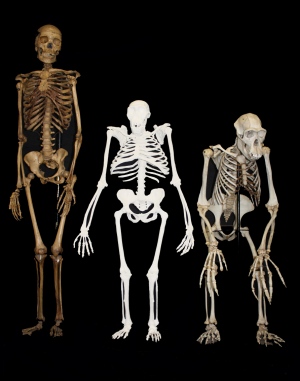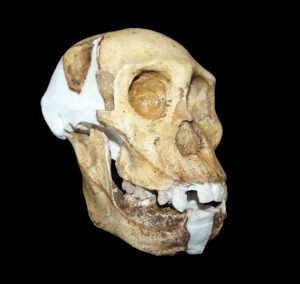Ape-like fossils show hints of human ancestry
The hominin Australopithecus sediba was a hodgepodge of simian and human-like features.
Article tools
Rights & Permissions
The two-million-year-old remains of a novel
hominin discovered in August 2008 are an odd blend of features seen
both in early humans and in the australopithecines presumed to have
preceded them. A battery of six studies1–6 published today in Science scrutinizes the fossils of Australopithecus sediba
from head to heel and yields unprecedented insight into how the
creature walked, chewed and moved. Together, the studies suggest that
this hominin was close to the family tree of early humans — although it
remains controversial whether it was one of our direct ancestors.
“We
see evolution in action across this skeleton,” says Lee Berger, a
palaeoanthropologist at the University of the Witwatersrand in
Johannesburg, South Africa. For instance, whereas the creature’s arms
are ape-like, its hands and wrists are remarkably like those of humans.
And although the hominin’s pelvis is shaped like a modern human's, its
torso included a narrow upper rib cage like those found in apes.
One of the six studies focused on Au. sediba’s teeth1,
comparing 22 different aspects across hundreds of teeth from several
other species of australopithecines and thousands of early human teeth.
Tooth similarities among the species are more likely to signify common
ancestry than independent evolution towards a beneficial design, says
Debbie Guatelli-Steinberg, an anthropologist at Ohio State University in
Columbus. That's because most of the characteristics the team chose to
study, such as the subtle curvature of a portion of the tooth’s surface,
are not likely to be evolutionarily useful.
Of the 22 dental traits considered by Guatelli-Steinberg and her colleagues, Au. sediba shared 15 with Australopithecus africanus and 15 with early humans. Moreover, says Guatelli-Steinberg, four of the traits shared by Au. sediba, Au. africanus
and early humans are not seen in earlier hominins — another sign of the
close evolutionary relationship between these two australopithecines
and early humans, she notes.
One of the most telling analyses in the set of studies relates to Au. sediba’s legs, and how the creature might have walked2.
For biomechanical models to adequately reconstruct a creature’s stride
and gait, researchers need to provide anatomical data about five body
parts: the heel, ankle, knee, hip and lower back, says Jeremy DeSilva, a
functional morphologist at Boston University in Massachusetts. “With Au. sediba,
we have all five, and the anatomy is flat-out different from what we
see in other australopithecines,” he notes. The individual pieces seem
strange in isolation, but together they tell a story, DeSilva adds.
Shuffle and swagger
His team’s models show that Au. sediba
would have walked very differently than modern humans. In each stride,
the first part of the creature’s foot to contact the ground would have
been the outer edge of the foot. (In modern humans, the heel strikes the
ground first.) As weight increasingly shifted to that foot, the foot
would have rolled inwards, causing a tremendous amount of rotation at
each of the leg joints. The result, says DeSilva, is a shuffling,
swaggering, flat-footed gait with short strides. “Whoa!” he says. “We
didn’t expect that.”
Au. sediba’s mode
of walking was probably a compromise, enabling it to shamble across
grasslands from one patch of woodland to another and then clamber around
within trees once it reached the forest, says DeSilva.
Physiological analyses of Au. sediba’s torso support this notion3.
The narrow, ape-like upper body suggests that the creature wouldn’t
have had large lung capacity, says anthropologist Peter Schmid, who led
the torso work and recently retired from the University of Zurich in
Switzerland. Also, the structure of the shoulder joints — an elevated,
'shrugged' arrangement well suited to climbing in trees and hanging from
branches — hints that Au. sediba couldn’t have swung its arms
well when it walked. Together, Schmid notes, these factors would have
limited the creature’s ability to breathe heavily when walking or
running.
Although most aspects of Au. sediba’s anatomy suggest that it is a close relative of early humans of the genus Homo,
exactly where the species lies within human evolution isn’t yet clear.
“We’re trying to be cautious with our interpretations,” says Berger.
Nevertheless, “from what we’re seeing, Au. sediba is a possible ancestor of Homo”, Berger says. “But if the creature is an ancestor of Homo, then the genus arose in a very different way than previously hypothesized.”
However,
ancestry and close kinship are two different things, and some within
the palaeoanthropology community dispute that the hominin was a direct
human ancestor. One such researcher is Donald Johanson, a
palaeoanthropologist at Arizona State University in Tempe who wasn’t
involved in the new studies. In Ethiopia in 1974, Johanson and colleague
Tom Gray discovered the fossils of “Lucy” (Au. afarensis)— a 3.2-million-year-old hominid whose 40-percent-complete skeleton is one of the most renowned fossils in the world.
“From what I have seen of the fossils, I think Au. sediba is another species of Australopithecus that confirms species diversity in early hominin evolution,” says Johanson. Although Au. sediba
“abundantly demonstrates a unique set of anatomical features”, he
notes, the species was probably a dead-end branch on the hominin family
tree.
- Nature
- doi:10.1038/nature.2013.12788


Nenhum comentário:
Postar um comentário
Observação: somente um membro deste blog pode postar um comentário.